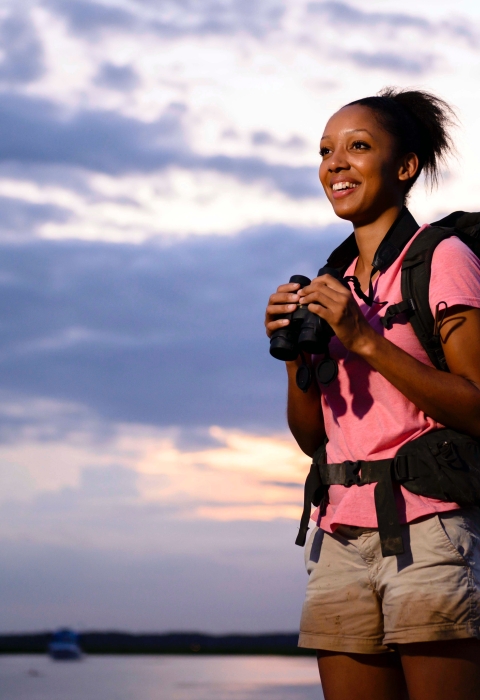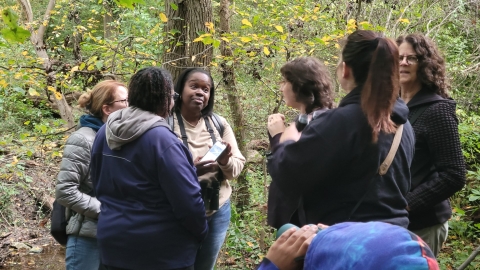When you think of the connection between Philadelphia and birds, the Philadelphia Eagles likely come to mind. Though we love watching those Birds, our feathered friends soaring the sky are just as valuable and are available to watch other times than Sunday afternoon — even in the heart of the city.
In the City of Brotherly Love, a variety of organizations and birders are working to make birdwatching more inclusive, accessible and diverse. And that benefits the birds and the watchers.
Urban bird data is unique and necessary
Since 1970, three billion birds have disappeared from North America's adult breeding population.
Urban residents are in a unique position to help. Though urban residents make up 80% of the U.S. population, only 54% of urban residents over the age of 16 participated in wildlife watching in 2022 compared to 68% of rural residents in the same year, according to the 2022 National Survey of Fishing, Hunting, and Wildlife-Associated Recreation. That means there’s plenty of space for urban residents to get involved in birding.
According to Keith Russell, program manager for urban conservation at Audubon Mid-Atlantic, in urban areas, the largest variety of birds occurs during migration. Attracted by the lights at night, birds use cities as stopover sites on their way to breeding grounds.
“Birds are forgiving with habitat preferences during migration but narrow in breeding season,” Russell said. He likens this to how people behave when they travel. “On a road trip from Philadelphia to Florida, you might eat at a sketchy restaurant or stay at a motel you wouldn’t normally stay at. You make choices to do things that are not ideal when traveling, and birds do the same thing.”
Urban areas offer publicly accessible places where we can monitor bird collisions — what types of buildings birds collide with most, what the weather conditions are like when collisions occur, and what species are involved. Although this phenomenon is understudied, it seems birds are learning to adapt to urban areas. In Philly, there are black vultures and turkey vultures living year-round in abandoned houses, which is just one example of how resilient birds can be; as conditions change, they adapt — up to a point.
Breaking down barriers to birding
In urban areas, there is a lot of stress — people screaming, cars honking, late night parties. Residents need opportunities to de-stress to support mental health and wellbeing. Connecting to birds can be therapeutic for anyone, but especially those exposed to stress and trauma. Birds and their songs are beautiful, and watching them provides a sense of serenity.
Unfortunately, many urban residents are disconnected from activities that introduce them to birds, due to a fear of the natural world, the misconception that nature is dirty or dangerous, and a culture that tells them, “This isn’t what we do.” Birding may be uncomfortable or intimidating for diverse participants because of a feeling of being different.
“The biggest barrier exists in people’s minds,” Russell says.
There was a shift in this mindset during the pandemic, as people like Katrina Clark were put in a position to reconsider what they could or should do. Unable to meet her best friend indoors, Clark walked the streets of southwest Philly with them every day.
On one of these trips, her friend pointed out a cat bird. Having never seen one before, Clark asked “What the hell is a cat bird, and what is it doing in Philly?” She soon learned it was not a lost and rare species but an incredibly common bird.
Motivated by this discovery, Clark set out to learn more about birds. She now serves as a board member of In Color Birding Club, an organization that strives to make the birding experience a positive one for Black, Indigenous, and People of Color and their allies.
Employing patience learned from 19 years as a teacher, Clark leads bird walks with the perspective that inclusivity is the key to reducing bird population declines. “If we don’t speak up about the value of green spaces, birds will disappear. We need anyone showing interest in birding not to be pushed out.”
To get interested in birding, people need to have what Russell calls “transformational experiences.”
“Those happen in nature,” he said. “Not by seeing a picture or reading, but by being in nature hearing bird songs, smelling the marsh and flowers, seeing a hawk dash down to catch a mouse. You have to encounter things in real life. That is the key.”
Gregg Gorton, immediate past-president of the Delaware Valley Ornithological Club and frequent bird- walk leader at John Heinz National Wildlife Refuge at Tinicum, says a walk leader must be humble and make people comfortable. “None of us know everything. Doesn’t matter how much or how little you know, there is always more to be learned.”
The practical barriers to birding are very low, Russell says. “You can bird by yourself. It doesn’t require lots of equipment … all you need is a way to identify birds, such as a cheap field guide and binoculars. You don’t have to travel; you can just walk your neighborhood.”
The Free Library of Philadelphia’s Birding Backpack program allows anyone with a library card to check out a birding backpack that contains binoculars, a birding field guide and list of birding apps such as iNaturalist, and a map of the area for three weeks at a time. While free for borrowers, each backpack costs the library $120. Fortunately, the Delaware Valley Ornithological Club made a $3,000 donation that was matched by the library, supporting 50 backpacks. The club also has a partnership with Kowa, a leading binocular brand, to make binoculars available to birders at cost.
One of the challenges of exposing urban children to nature and birds is transportation. In Color Birding Club offers a bus scholarship to get students to green spaces. So far, all teachers who have applied were fully funded and able to get several classes out on field trips at no cost to students’ families. The scholarship is funded by donations and grants.
Delaware Valley Ornithological Club donated to the fund and has also donated to a similar bus scholarship program maintained by the John Heinz National Wildlife Refuge’s Friends group.
Philadelphia is even a member city of the Service's Urban Bird Treaty program, which supports city partners in conserving birds and their habitats and providing opportunities for community engagement in bird-related recreation, education, and conservation activities in urban and suburban areas.
No time like the present
Thanks to the efforts of many, Philly residents have more opportunities than ever to birdwatch. But you can join them from anywhere.
And Russell says the best time to bird is now: “It's a great time to get interested in birds. Though there is a decline in bird numbers, there has never been more info available on how to be a birder and identify birds.”







